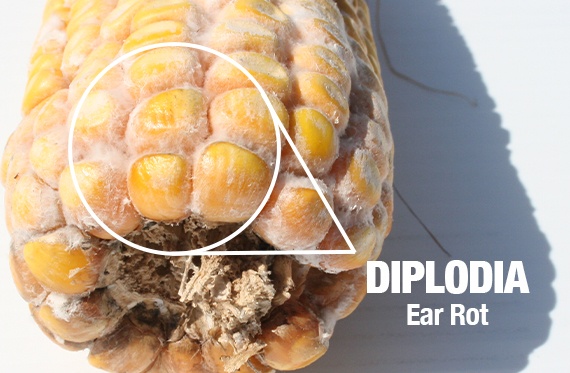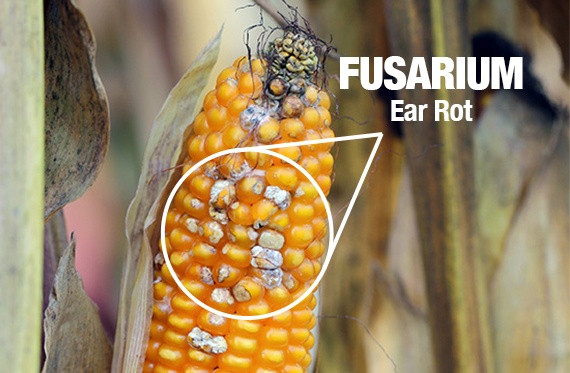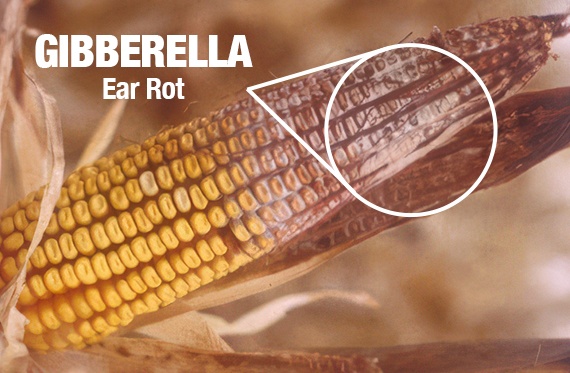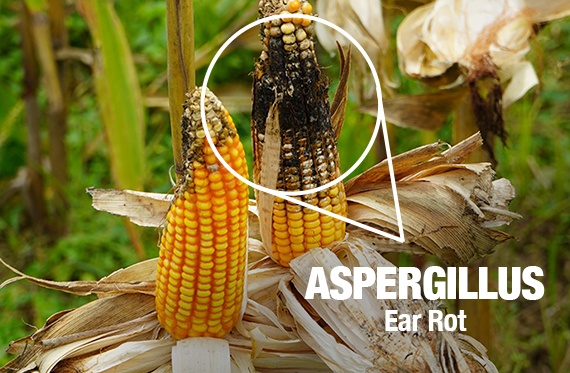Spot the Difference: Four Common Corn Ear Rots
Manage disease and prevent the spread of dangerous mycotoxins by identifying common corn ear rots like Diplodia, Fusarium, Gibberella and Aspergillus.

Ear rots plague growers regardless of region and weather. These fungi are most commonly found in corn in the Midwest, Upper Midwest, Central Plains and Northern Plains. Infections can cause lighter, lower quality kernels, introduce mycotoxins that impact feed value and reduce marketable yields. There are different management options, but first, it is important to identify what type of ear rot you are dealing with.
Diplodia Ear Rot

Diplodia ear rot is very common in cool and wet environments. To determine if you are dealing with Diplodia, you need to look out for white mold, with coverage ranging from the base of the ear to the entire ear. The white moldy kernels will also have raised black bumps on them also known as, pycnidia.
A common way to manage this specific disease is by adjusting your combine settings to discard the diseased kernels. University of Kentucky Extension recommends quickly drying the affected grains to 15-16% to keep the disease from spreading in storage. As with any fungus, be sure to store the infected grain away from healthy yields.
Fusarium Ear Rot

Fusarium ear rot often occurs in warm and dry environments. The first symptom in a crop affected by Fusarium verticillioides is a white or pinkish fungal growth on the kernels. The fungi present in this disease can also produce mycotoxins which can affect livestock, especially pigs and horses. To manage Fusarium, dry infected grain quickly and store at or below 18% moisture.
Gibberella Ear Rot

Gibberella is commonly found in cool and wet temperatures. It also produces mycotoxins which primarily affect swine. Corn infected with Gibberella will have pink to red fungal growth on the tips of the ear. If the disease is severe, the silks and husk will sometimes stick to the ear. Similar to Fusarium, manage this disease by storing the grains at or below 18% moisture to reduce the spread.
Aspergillus Ear Rot

Another mycotoxin-producing fungus, Aspergillus flavus occurs in hot and dry environments. Look out for yellow to olive-colored spores on the end of the ear and powdery mold between the kernels. You may also notice the fungus overwintering on soil debris which infects next season’s kernels through wind and insect damage.
Stressed plants are most susceptible to Aspergillus ear rot. To set corn up for success, choose hybrids that tolerate drought stress, provide fertilizers and consider reevaluating your insect management plan.
No grower wants to deal with ear rot disease, mycotoxins, or lost yields – that’s why it’s important to be able to identify them and take action. If you suspect ear rots are impacting your fields, speak with your local Syngenta representative for additional recommendations.
3 Min Read
- Corn ear rots are a persistent problem across regions and weather conditions.
- Learning the identifying characteristics of corn ear rots can help growers preserve yields and prevent the spread of dangerous mycotoxins.
- Management may include adjusting equipment at harvest and quickly drying affected grains.
More Articles About Field Insights
RECOMMENDED FOR YOU
3 Min Read























